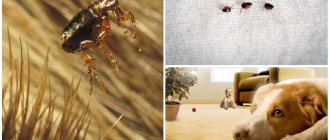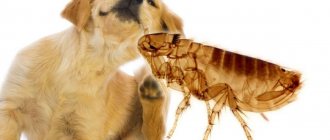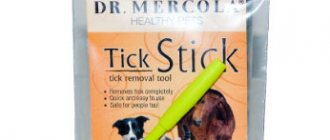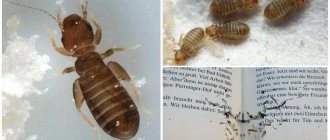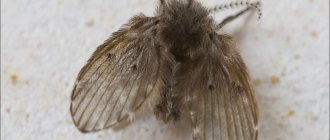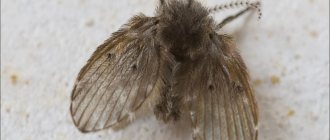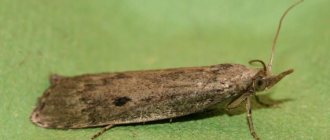The appearance of fleas in a dog always causes concern for the owner, who monitors his own health and the health of his pet. This is the correct reaction, because fleas are carriers of many diseases that are dangerous to both animals and humans.
A flea is a blood-sucking insect that parasitizes warm-blooded animals and humans. They feed on the blood of their owner, biting through his skin. The size of dog fleas is about 3 mm. They have increased fertility: the female lays up to 25 eggs per day. Insects have developed jumping ability, so they can easily jump from a dog to another animal or to people.
The mechanism of transmission of pathogens of various diseases: a flea, having drunk blood from a sick animal or person, bites another “food item” and introduces an infection into the wound, from which pathogenic viruses and bacteria spread through the bloodstream. This is how infection occurs.
Causes and signs of fleas
Every dog gets fleas from time to time. Even animals living in an apartment are not immune from this scourge. Fleas make jumps up to 30 cm in height and length, which means that you can “pick up” a flea anywhere.
Most often, fleas settle on dogs after the following episodes:
- a walk in the courtyard of the house;
- visiting a park or forest;
- traveling on public transport;
- participation in exhibitions;
- contact with another animal (cat, rabbit, rat, mouse, dog).
People can also bring fleas into the house - on clothes or shoes.
The first sign that your pet has fleas is frequent scratching. In this way, the animal tries to get rid of the annoying insect. The sign of a bite can be detected by parting the fur. A small red spot with a drop of dried blood is clearly visible on the skin.
Precautionary measures
To reduce the risk of flea infestation, you should:
- protect your pet from contact with homeless animals;
- If you go to nature or your dog participates in a hunt with his owner, be especially careful. In nature, animal burrows (especially foxes) and bird nests are breeding grounds for fleas;
- Don't think you don't have to worry about fleas in winter. On the street they die from frost, but remain in warm houses. So preventive measures against fleas should be carried out both in winter and in summer.
How dangerous are blood-sucking parasites for humans?
Dog fleas do not live on a person, but they can bite if they are on his body. The most “innocent” consequence is skin irritation at the site of the bite. This is how a local allergic reaction is expressed. If you scratch this wound, there is a risk of causing a so-called “secondary infection.” In this case, the bite site festers, and pathogenic microflora enters the body through the bloodstream. If left untreated, sepsis (blood poisoning) may occur.
A flea can infect humans with the following diseases:
- brucellosis – multiple lesions of the human body systems (cardiac, digestive, motor, reproductive, etc.);
- helminthiasis - parasitic worms that settle in the digestive and other systems of the body;
- encephalitis – brain damage;
- salmonellosis - an acute infection of the gastrointestinal tract;
- tularemia – damage to the lymph nodes and severe intoxication of the body.
Any of the listed diseases caused by fleas from a dog is a serious test for the body and never goes away without consequences.
Parasitic insects can cause a lot of problems for your pet. Flea bites are very irritating to dogs, they become nervous, eat less well and sleep poorly. Scratching flea bites leads to ulcers and hair loss. This disease is called flea dermatitis.
In addition, fleas can infect a dog with the following diseases:
- cucumber tapeworm (dipylidia) is a tapeworm up to 70 cm long that parasitizes the small intestine of an animal. Infection occurs when an animal ingests an infected flea;
- distemper is an infectious disease that affects the mucous membranes and central nervous system of an animal;
- brucellosis;
- anemia (anemia) if the dog has a lot of fleas.
Considering the listed diseases that can result from bites of blood-sucking parasites, the question of how to remove fleas from a dog is very relevant.
Briefly about the main thing
- Fleas are blood-sucking insects that attack warm-blooded animals and are dangerous to humans
- Fleas do not live on animals, they only feed on them, but live in the environment. A dog can pick up this parasite anywhere, either from another dog or on the street, and you can even bring them into the house on your shoes.
- Your pet may not show any symptoms if bitten, so your attention is important.
- To get rid of fleas, it is very important to choose the right drug.
- You will not get rid of fleas if you do not treat the room for them. Pregnant and lactating dogs can only use drugs that are safe for use.
Review of flea products for dogs
You can remove fleas from a dog at home without much effort and with a minimal investment of time and money using commercially produced products. These drugs contain substances that either repel fleas, have a destructive effect on their central nervous system, or render their offspring unviable.
Plant and synthetic insecticides are used as active substances in the production of flea products.
The most effective of them are the following:
- pyrethrins – made from natural raw materials, they have a gentle effect on the dog’s body without causing intoxication. Fleas die from paralysis of the central nervous system;
- pyrothroids are synthetic analogues of pyrethrins. They have a more powerful effect, therefore they are not used in products intended for the extermination of fleas in dogs during puppyhood;
- imidacloprid and clothianidin are nicotine derivatives that have a toxic effect on insects, but do not harm the animal;
- diazinon and fipronil - cause paralysis in fleas;
- selamectin - helps kill not only fleas, but also ear mites, as well as some types of helminths.
Modern anti-flea agents, as a rule, combine several types of active substances and therefore have a combined effect on several types of parasitic insects.
The dosage of the active substance, as a rule, depends on the weight of the dog and its age. It is important to remember that products for an adult animal are not suitable for puppies or pregnant dogs. Therefore, you should carefully study the instructions for the drug before using it.
Where do fleas come from?
A distinctive feature of fleas is their unique jumping ability, which allows them to easily move through their environment. The flea is capable of jumping up to 50 - 70 cm and up to a meter in the horizontal direction! Being in the environment, with the help of antennas sensitive to temperature and vibration of air flow, the flea is able to find a dog, even if it passes a meter away from it.
The flea life cycle, including eggs, larvae and pupae, occurs in the environment, usually close to the dog's habitat (bedding, carpets, floor cracks, soil surfaces and dust). Flea pupae can survive in a cool, dry room for 6 months to a year. When favorable conditions occur, adult fleas quickly hatch and land on the dog. Thus, fleas found on dogs are only 1–10% of the entire flea population in the animal’s environment.
Adult insects spend most of their lives on their host; only 3–8% of adult fleas move from one animal to another. Therefore, the main source of infection is the environment.
Shampoo
Shampoo is the mildest flea treatment for dogs. It contains either insecticides or essential oils in a minimal dosage. Therefore, shampoos can be classified more as a hygienic and preventive product than as a therapeutic one.
It is important that when washing the dog, the shampoo foam does not get on the mucous membranes of the dog’s mouth or eyes. If this does happen, then it is necessary to immediately rinse the animal’s mucous membranes with plenty of clean water.
Flea shampoos for dogs are classified depending on the active substances they contain:
- insectoacaricidal - one of the components is a plant or synthetic insecticide in a minimum concentration that kills adult fleas and their larvae. The effect of this shampoo is up to 3 months (depending on the active substance used). Such products include “Mister Bruno” shampoos from the manufacturer Fitoelite;
- natural – the shampoo contains essential oils that repel fleas from dogs with their scent. The action lasts for 1 week. This product is suitable for small puppies, old and pregnant dogs. For example, “Green Fort” shampoo from the German company Neoterica, Russian “Doctor Zoo”;
- combined - contain both repellents and insecticides. The action lasts up to 3 weeks. Such shampoos include: “Lugovoy”, “Clandestine”.
Benefits of using flea shampoo:
- low toxicity;
- ease of use;
- the ability to simultaneously remove street dirt, house dust, mites (ear and forest mites), lice-eaters, and fly larvae.
How to identify in puppies?
Young puppies can become infected with parasites from their mother or while walking. This is especially dangerous for them. The immune system of little babies has not yet developed enough to withstand serious infections.
You should not undertake treatment on your own. You will definitely need to consult a specialist. Not all methods may be suitable for a small organism. Avoid products that are not intended for puppies and have a strong herbal scent. It can affect the puppy's sense of smell, which is just beginning to develop.
Drops
Flea drops for dogs are the most effective and easy-to-use remedy for killing fleas on animals. To produce drops, “shock” dosages of active substances are used that destroy or expel parasitic insects. The drops are applied to the dogs' withers, after spreading the fur.
The duration of action depends on the concentration of the active substance. To avoid re-infestation, the drug must be applied again as soon as the period of exposure to the drops after the previous application has expired. This is especially important for dogs that are often free-range.
Pet owners should remember that the amount of flea medication for dogs is calculated based on the weight of the animal being treated. An overdose can result in severe intoxication of the body.
Drops that have been successfully tested and are popular among dog breeders and recommended by veterinarians:
- "Stronghold" from the American manufacturer Zoetis. The active substance – selamectin, effectively destroys fleas and ticks at all stages of development, does not have a harmful effect on the health of the dog;
- "Bars" of domestic production. The active elements are the insecticides praziquantel and ivermectin. The drug can be used by puppies from 2 months.
Many anti-flea drops have been developed; it is impossible to list them in one article. You can choose the best option for your dog experimentally or by consulting a veterinarian.
Prevention of infection
Use collars as a preventative measure after treatment with drops and sprays, but only after two to three weeks. The duration of action of the active substance is from 2 to 7 months. Cost from 80 rub. up to 1.5 thousand rubles To prevent infection, place branches of wormwood, lemon balm, lavender around the house, fill the litter with sawdust from coniferous trees - pine, juniper, spruce. Be sure to give your dog an anti-helminth medication after removing fleas to eliminate the risk of infection. After all, fleas are active carriers of tapeworms and other parasites. Don't forget that you too have been in contact with an infected animal. Take care of prevention for yourself and your loved ones.
Video
Pills
Flea tablets for dogs are an innovation in the veterinary market. For the first time, you can not apply flea treatment to the animal, but let it take it orally.
Benefits of taking the pills:
- some types of tablets can be used for both adult dogs and puppies, pregnant and old dogs, having previously calculated the dosage;
- no side effects;
- After taking the tablets, the dog can be petted; there are no traces of insecticides on the fur.
The mechanism of action of flea tablets in dogs: the drug, entering the digestive system, penetrates the animal’s blood. A flea, having bitten the skin of a dog, receives a portion of the toxin, from which it dies.
All tablets sold in veterinary pharmacies have been vetted. control, therefore safe for the health of dogs. The most popular drugs are:
- “Bravecto” (Austria/Netherlands) – tablets are taken once every 3 months;
- “Frontline Nexgard” (France) – a single dose lasts 4 weeks;
- "Simparinka" (Zoetis) - taken once every 35 days.
All drugs have certain contraindications, so be sure to read the instructions.
Symptoms indicating a dog infection
The owner of a pet should know how flea infestation manifests itself. This will help to start treatment in a timely manner and save your pet from possible complications.
Dog breeds with thick hair need to be brushed regularly. White flea eggs can be seen with the naked eye. If mature fleas are not visible, this does not mean that there is no lesion. Having carefully examined the dog’s body, paying special attention to the abdominal area, you can notice dark grains. These are waste products of blood-sucking parasites.
Fleas on a dog look quite specific. It is difficult to confuse them with a tick. These are active bloodsuckers, quickly scattering into the undercoat if disturbed. They are afraid of water, so while bathing your pet, you can notice how parasites simply jump off it in different directions.
In addition to examination, the following signs may indicate the presence of fleas in a dog:
- the animal is constantly, incessantly itching;
- the dog suddenly jumps up, trying to bite itself, especially in the area of the root of the tail;
- the appearance of red spots on the skin;
- formation of alopecia, ulcerative lesions and scratches on the skin;
- animal whining;
- the beginning of molting earlier than the seasonal period;
- restlessness and irritability of the dog;
- refusal to eat, insomnia;
- a sharp decrease in body weight.
In the absence of timely antiparasitic treatment, in addition to the above symptoms, dyspeptic disorders, changes in the color of visible mucous membranes, and an increase in body temperature are added.
Making an accurate diagnosis is not particularly difficult. The doctor conducts a general clinical examination, paying special attention to the coat and skin condition.
For greater accuracy, prepare a white sheet of paper soaked in water, and comb the patient's fur with a thick comb over this sheet. With a positive diagnosis, small brown spots appear on a white sheet of paper. This is flea excrement.
Differential diagnostics are carried out to check for the presence of lice, mites or lice. If the dog itches and no fleas are found, the cause may be an allergic reaction to food components, folliculitis (inflammation of the hair follicles), skin itching due to nervous disorders, or fungal infections of the skin.
Collar
A flea collar for dogs is a strap made of porous material, impregnated with a substance that kills or repels fleas. Worn around the neck, designed to prevent the appearance of parasitic insects. It is impossible to cure an animal of fleas using this remedy alone. The fact is that the collar is intended to be worn constantly, so its impregnation contains active components in minimal quantities so as not to harm the dog’s health.
Important: collars for puppies under 2 months are not recommended.
Experts note the effectiveness of many types of collars. For example, “Fitodoc” based on natural repellents, “Rolf club 3D”, which repels almost all types of blood-sucking insects.
Exposure to heat
Fleas do not like temperature rises above 30°C. In this case, they try to find a more suitable place to live as quickly as possible.
- 70°C – this is the temperature at which fleas die instantly.
- To kill an insect at 53°C, the temperature must remain in effect for at least 25 minutes. To achieve the effect, it is best to use a steam generator or an iron with a steam function.
The effects of heat on fleas
How to remove fleas from a dog at home
You can treat your dog for fleas either yourself or by going to a veterinary clinic.
Since the dog began to live in a person’s house, people began to look for means to rid animals and their homes of fleas. Some of the folk remedies are very effective. For example, you can exterminate insects that have settled in carpets in a simple and cheap way: with a mixture of salt and soda. Salt has powerful dehydrating properties, so when it hits an insect, it literally dries it out. Baking soda is toxic to flea eggs and larvae.
What should be done:
- mix soda and fine table salt in equal proportions;
- apply to carpets with a brush or broom;
- leave for 10 - 12 hours, and then clean the carpet with a vacuum cleaner.
This procedure must be repeated every 4 days for 2 weeks.
To remove fleas from a dog at home, you can use wormwood tincture. Recipe:
- you need to collect and dry wormwood;
- grind the grass and pour vodka into it. Approximate proportions: ½ cup of crushed wormwood to 1 cup of vodka;
- leave for 2 weeks in a dark place and strain.
An aqueous solution of this tincture should be used to thoroughly treat all of the animal’s fur. Solution proportions: 1/3 cup of tincture per ½ liter of water.
Only a few people can afford to waste time going out of town to collect herbal remedies for fleas or spray the room with salt and soda several times. Therefore, veterinary companies develop and produce a wide variety of products that allow you to destroy the block without harm to your pet.
How do they reproduce?
The reproduction of fleas directly depends on their habitat. The average body temperature of a dog varies from 37 to 39 ° C, and fleas, in turn, are heat-loving insects. Reproduction can occur on the animal itself or in some other secluded place: in upholstered furniture, on carpets, etc. Having laid eggs, the adult continues to parasitize the animal, and the egg begins to develop into a larva, after which the larva becomes a pupa, and then transforms into a flea. The pupa is protected by a stable shell and can live inside without feeding for almost a year.
Often, after complete treatment with anti-flea drugs (drops, shampoos, collars), a relapse of these insects can be detected - this is exactly the case when the pupa spent several weeks or months in a protective shell, and then transformed into a flea. While on the animal's body, the flea can feed every day, while when there is no suitable victim, the bloodsucker can go without food for up to two weeks.

